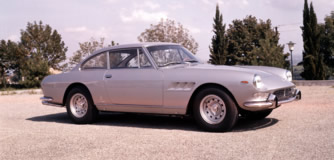|
As with its predecessor, the body design of the 330 GT 2+2 was from the pen of Pininfarina. It was very different, however, featuring a canted twin headlight arrangement, with a 7 in diameter outer lens and a 5
in diameter inner, echoing the layout shown on the 400 Superamerica Superfast IV (chassis 2207SA). This gave the frontal aspect a slightly American look, as dual headlights were very much in vogue there. The general body lines
became smoother and rounder, apart from the angular headlight surround pods, featuring a bulbous, rounded tail providing a more voluminous boot, with horizontal rectangular one-piece rear light assemblies that curved around the
edges of the wings. The 50 mm increase in wheel base over its predecessor, together with a redesigned interior, gave rear seat passengers additional leg and head room, without any sacrifice to that of the front seats.
The series II example came into being when the frontal treatment was altered around the middle of 1965. At that time, the twin headlight arrangement was replaced by a single unit, which gave a frontal aspect very similar to
that of the concurrently produced 275 GTS model. At the same time, the Borrani wire wheels (for so long a standard part of Ferrari attire) gave way to ten-hole cast alloy wheels, still with the knock-off Rudge hubs, although
the wire wheels remained available as an option. The design of the engine bay exhaust air louvres on the front wings changed from the 11-slot arrangement of the 250 GTE to a triple row design, which was also used on the 275 GTS
from around the same time, while the front and rear bumpers gained rubber-faced over-riders. The interior also underwent modification: the floor-mounted pedal box changing to a suspended unit, a central console provided between
the transmission tunnel and the lower edge of the dash panel, with changes to the layout of the switchgear and ventilation outlets.
The bodies were mounted on a 2650 mm wheel base chassis that had factory reference
number 571 (series I) and then 571/65 (series II). All were numbered in the odd chassis number road car sequence, in the range 4963 to 7533 for Series I models, and 7537 to 10193 for Series II. Construction was to standard
Ferrari practice for the period: large section oval main tubes with substantial cross bracing, and sub assemblies welded to the main frame to support the body and ancillary equipment. The model had independent front suspension,
a rigid rear axle with leaf springs and telescopic shock absorbers, four wheel disc brakes with separate front and rear hydraulic circuits, either left- or right-hand steering, available with optional power assistance later in
the production run.
The engine was a single overhead camshaft per bank 4-litre V12 unit, with factory type references 209 and then 209/66, a total cubic capacity of 3967 cc, and a bore and stroke of 77 x 71 mm. It had
an outside vee spark plug arrangement, fitted with a bank of three twin choke Weber 40 DCZ/6 or 40 DFI carburettors, a twin coil and a rear of engine-mounted distributor ignition system producing a claimed 300 bhp. The engine
was based on the original Colombo 'short' block design, but was slightly longer with increased bore centres to provide adequate waterways with the larger diameter cylinder bores. The difference in engine type number referred to
the number of mounting points: 209 had four, while 209/66 had two, the latter arrangement being used from chassis 08729. The engine was coupled to a 4-speed, all synchromesh gearbox, with an electronically operated overdrive
fifth gear on most Series I cars, and a 5-speed, all synchromesh gearbox on late Series I, and all Series II cars, and a final drive through a propeller shaft to a rigid rear axle. With the change from the 4- to 5-speed
gearbox, the clutch actuation system went from mechanical to hydraulic operation.
Production for the 330 GT 2+2 ran from 1964 to 1967, when it was replaced by the 365 GT 2+2. During this time, 625 Series I and 474 Series
II examples were produced, outselling the preceding 250 GT 2+2 model during a similar production life span; the 2+2 concept proving to be a very popular ongoing configuration.
Engine
- Type front, longitudinal 60° V12
- Bore/stroke 77 x 71 mm
- Unitary displacement 330.62 cc
- Total displacement 3967.44 cc
- Compression ratio 8.8 : 1
- Maximum power 221 kW (300 hp) at 6600 rpm
- Power per litre 76 hp/l
- Valve actuation single overhead camshaft per bank, two valves per cylinder
- Fuel feed three Weber 40 DCZ/6 carburettors
- Ignition single spark plug per cylinder, two coils
- Lubrication wet sump
- Clutch single-plate
Chassis
- Frame tubular steel
- Front suspension independent, unequal-length wishbones, coil springs, telescopic shock absorbers, anti-roll bar
- Rear suspension live axle, twin radius arms, semi-elliptic springs, coil springs over telescopic shock absorbers
- Brakes discs
- Transmission 4-speed + overdrive + reverse
- Steering worm and sector
- Fuel tank capacity 90 litres
- Front tyres 205 x 15
- Rear tyres 205 x 15
Bodywork
- Type 2+2 coupé
- Length 4840 mm
- Width 1715 mm
- Height 1360 mm
- Wheelbase 2650 mm
- Front track 1397 mm
- Rear track 1389 mm
- Weight 1380 kg (dry)
Performance
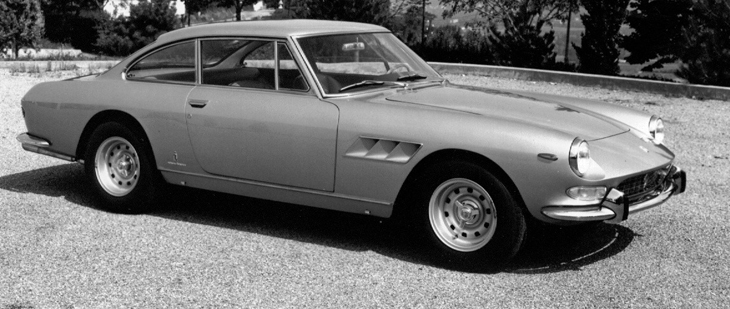
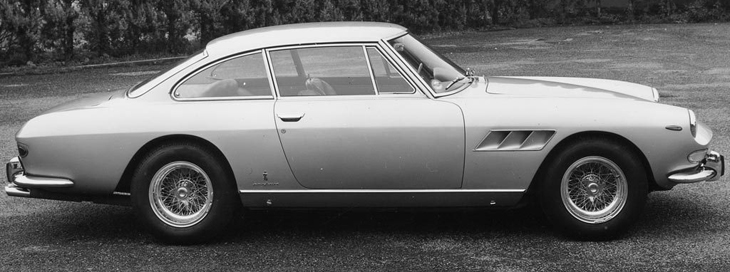
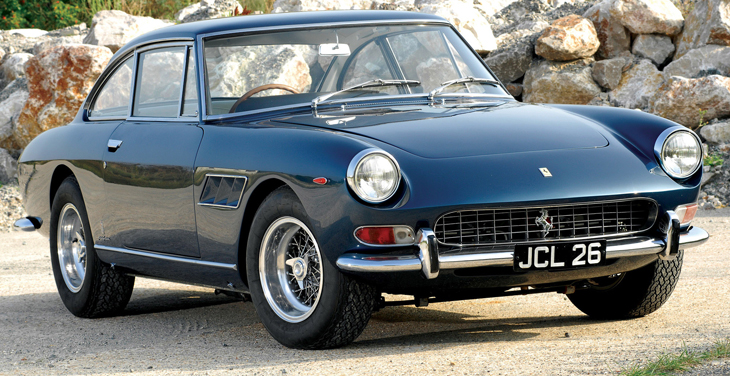
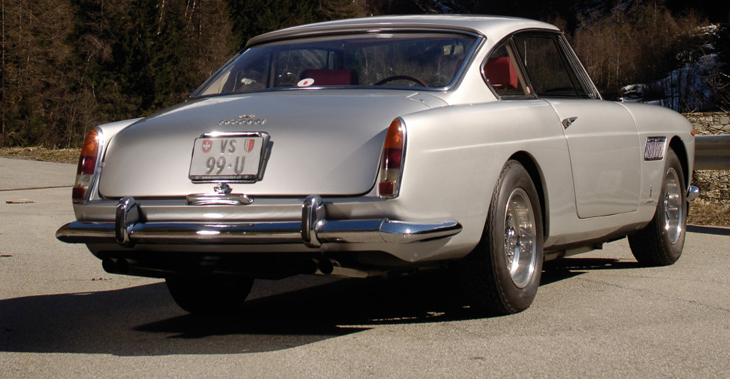
|
